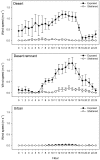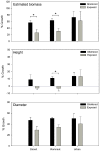Reduced wind speed improves plant growth in a desert city
- PMID: 20548790
- PMCID: PMC2883576
- DOI: 10.1371/journal.pone.0011061
Reduced wind speed improves plant growth in a desert city
Abstract
Background: The often dramatic effects of urbanization on community and ecosystem properties, such as primary productivity, abundances, and diversity are now well-established. In most cities local primary productivity increases and this extra energy flows upwards to alter diversity and relative abundances in higher trophic levels. The abiotic mechanisms thought to be responsible for increases in urban productivity are altered temperatures and light regimes, and increased nutrient and water inputs. However, another abiotic factor, wind speed, is also influenced by urbanization and well known for altering primary productivity in agricultural systems. Wind effects on primary productivity have heretofore not been studied in the context of urbanization.
Methodology/principal findings: We designed a field experiment to test if increased plant growth often observed in cities is explained by the sheltering effects of built structures. Wind speed was reduced by protecting Encelia farinosa (brittlebush) plants in urban, desert remnant and outlying desert localities via windbreaks while controlling for water availability and nutrient content. In all three habitats, we compared E. farinosa growth when protected by experimental windbreaks and in the open. E. farinosa plants protected against ambient wind in the desert and remnant areas grew faster in terms of biomass and height than exposed plants. As predicted, sheltered plants did not differ from unprotected plants in urban areas where wind speed is already reduced.
Conclusion/significance: Our results indicate that reductions in wind speed due to built structures in cities contribute to increased plant productivity and thus also to changes in abundances and diversity of higher trophic levels. Our study emphasizes the need to incorporate wind speed in future urban ecological studies, as well as in planning for green space and sustainable cities.
Conflict of interest statement
Figures



References
-
- United Nations. World urbanization prospects: the 2007 revision population database. 2008. Available online at: http://esa.un.org/unup/: United Nations Department of Economic and Social Affairs, Population Division, New York.
-
- McGranahan G, Marcotullio P, Bai X, Balk D, Braga T, et al. Urban systems. In: Hassan R, Scholes S, Ash N, editors. Ecosystems and Human Well-being: Current State and Trends: Island Press; 2005. pp. 795–825.
-
- Changnon SA. Inadvertent weather modification in urban areas: lessons for global climate change. Bulletin of the American Meteorological Society. 1992;73:619–627.
-
- Grimm NB, Faeth SH, Golubiewski NE, Redman CL, Wu JG, et al. Global change and the ecology of cities. Science. 2008;319:756–760. - PubMed
-
- Shochat E, Warren PS, Faeth SH, McIntyre NE, Hope D. From patterns to emerging processes in mechanistic urban ecology. Trends in Ecology & Evolution. 2006;21:186–191. - PubMed
Publication types
MeSH terms
LinkOut - more resources
Full Text Sources
Research Materials

